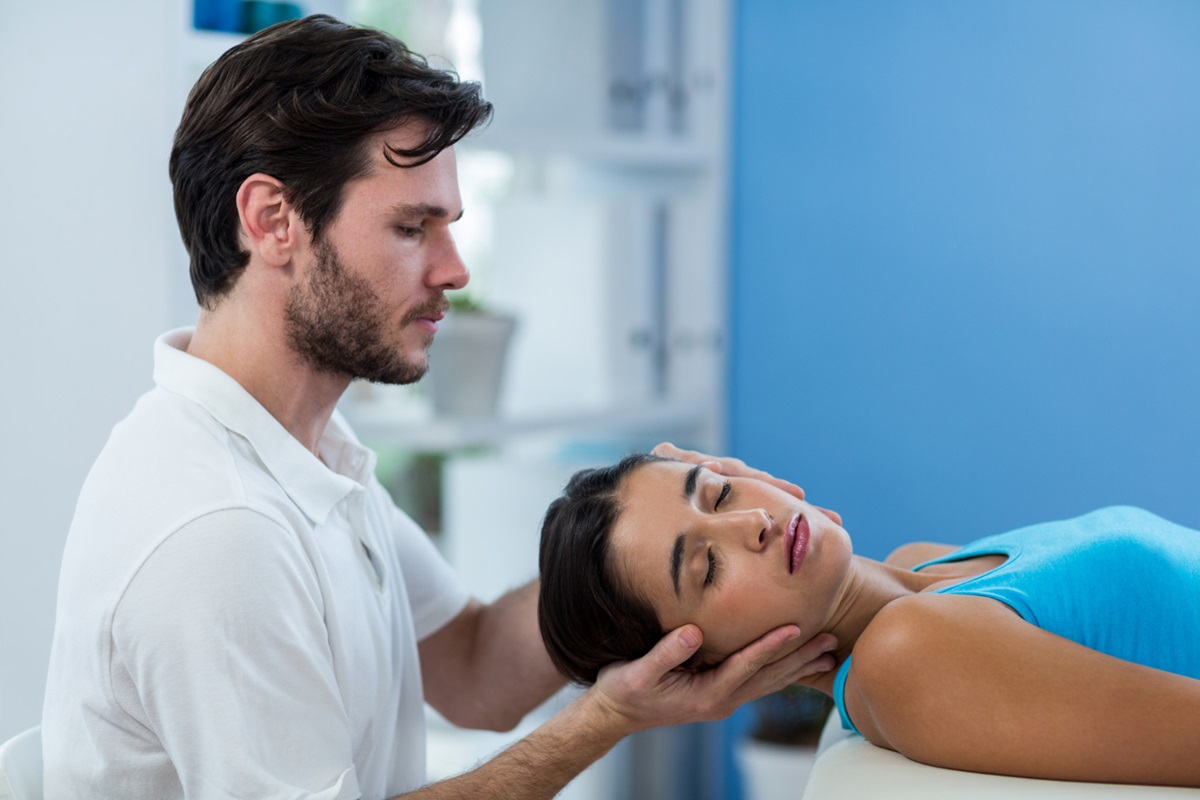If you’ve been struggling with jaw pain, clicking sounds, difficulty chewing, or persistent headaches, you might be dealing with a temporomandibular joint disorder (TMD). These symptoms can significantly impact daily life, making it hard to speak, eat, or even rest comfortably. Fortunately, TMJ physical therapy offers a highly effective, non-invasive solution to help manage symptoms and restore function. Through targeted techniques and individualized treatment plans, physical therapy for TMJ dysfunction addresses the root causes of pain and improves jaw mobility.
Whether you’re experiencing acute discomfort or have long-standing issues with your jaw, physical therapy for TMJ pain can help reduce tension, improve posture, and prevent future flare-ups. With a professional evaluation and a consistent care routine, most patients experience significant relief and return to normal activity levels. TMJ Dysfunction Treatment with Physical Therapy not only restores functional movement but also improves overall quality of life by reducing chronic pain, preventing recurrence, and promoting jaw stability.
Understanding TMJ Disorders and Their Impact
Temporomandibular joint disorders affect the temporomandibular joints, which are responsible for connecting your jaw to your skull. These complex joints are essential for chewing, speaking, and yawning. When dysfunction occurs—whether from trauma, inflammation, or abnormal movement—patients often experience considerable discomfort that requires targeted care, such as TMJ physical therapy.
What Is Temporomandibular Joint Dysfunction (TMD)?
TMD is an umbrella term encompassing a range of conditions that cause dysfunction and pain in the jaw joint and surrounding muscles. This can include jaw pain, jaw locking, difficulty opening or closing the mouth, or even malocclusion (misaligned bite). Factors like bruxism, teeth grinding, clenching, arthritis, and even genetics can contribute to the development of TMD. Left untreated, TMD can lead to degenerative conditions, jaw dislocations, or fractures.
Research indicates that temporomandibular joint and muscle disorders (TMJD) affect approximately 5% to 12% of the general population. Interestingly, unlike many other chronic pain conditions, TMJ disorders are more frequently observed in younger individuals, making early detection and TMJ physical therapy even more critical.
Common Causes and Risk Factors of TMJ Disorders
TMJ disorders can arise from a wide array of factors, including:
- Jaw injuries or trauma
- Misalignment of the jaw
- Teeth grinding (bruxism) or clenching
- Chronic stress
- Arthritis or other musculoskeletal conditions
- Genetics or developmental anomalies
Understanding these risk factors is critical in developing an effective physical therapy for TMJ dysfunction program.
Among various types of TMJ disorders, disc displacement with reduction (DDwR) is the most common, affecting nearly 26% of adults and elderly individuals, and about 7.4% of children and adolescents. This highlights the importance of early physical therapy for TMJ dysfunction to manage symptoms and prevent progression across age groups.
Symptoms Indicating the Need for Physical Therapy
Signs that may indicate the need for TMJ physical therapy include:
- Jaw pain, stiffness, or tenderness
- Clicking, popping, or locking of the jaw
- Facial pain, earaches, and tinnitus
- Headaches, neck pain, and shoulder pain
- Difficulty opening or closing the mouth
These symptoms often interfere with daily tasks like eating and speaking. If left unaddressed, they may worsen or contribute to other chronic pain disorders. A physical therapy screening can provide early insight into appropriate treatment paths.
The Role of Physical Therapy in TMJ Treatment
A team-based approach is often the most effective strategy for managing TMD. This can include collaboration between dentists, primary care providers, and physical therapists. TMJ physical therapy specifically focuses on musculoskeletal factors contributing to joint dysfunction.
How Physical Therapy Addresses TMJ Dysfunction

Physical therapy for TMJ aims to restore joint alignment, alleviate muscle tension, and improve function through a structured treatment plan. Therapists conduct a thorough assessment, including posture analysis, palpation of jaw and neck muscles, and evaluation of jaw mechanics. Treatment may include manual treatments, joint mobilizations, and dry needling techniques to relieve tension and stimulate healing.
Benefits of Physical Therapy for TMJ Pain Relief
Benefits of physical therapy for TMJ pain include:
- Reduced jaw stiffness and improved range of motion
- Decreased jaw pain and frequency of headaches
- Relief from earaches and tinnitus
- Enhanced muscular control for chewing and speaking
- Long-term stabilization of your jaw
Additionally, TMJ physical therapy often helps patients reduce reliance on medication and avoid more invasive surgical TMJ treatments.
Comparing Physical Therapy to Other Treatment Options
Unlike medication or surgery, physical therapy for TMJ pain provides long-term relief by addressing the mechanical and muscular components of jaw dysfunction. When combined with relaxation techniques, massage therapy, acupuncture, and avoiding specific triggers, physical therapy offers a holistic, non-invasive path to recovery. For severe cases, therapy may be used before or after surgical intervention to reconstruct or repair joint structure.
Comprehensive Physical Therapy Approaches for TMJ
A successful treatment plan for TMJ dysfunction goes beyond isolated techniques. Physical therapy offers a well-rounded, individualized approach that incorporates hands-on interventions, strengthening routines, postural correction, and therapeutic modalities. These elements work together to relieve pain, restore jaw function, and prevent long-term complications.
Manual Therapy Techniques for Jaw Mobility
Manual treatments are a foundational part of TMJ physical therapy. These hands-on techniques involve soft tissue mobilization, myofascial release, and trigger point therapy to reduce muscle tension and improve blood flow. Specific attention is given to the temporalis, masseter, and pterygoid muscles to improve function and decrease pain.
Therapeutic Exercises to Strengthen Jaw Muscles
Therapists prescribe exercises such as:
- Resisted opening of the mouth
- Resisted closing of the mouth
- Jaw stabilization exercises
These help retrain the muscles around the jaw and promote better coordination. Implementing these regularly as part of your physical therapy for TMJ dysfunction plan ensures improved functional outcomes and pain reduction.
Postural Training and Its Importance in TMJ Management
Postural correction is crucial in managing tmj disorders, especially in those with forward head posture or spinal misalignment. Exercises like chin tucks and shoulder retraction drills strengthen postural muscles and relieve stress from the jaw joint. Ongoing posture improvement reduces recurrence and supports other TMJ physical therapy interventions.
Use of Modalities: Ultrasound, TENS, and Heat Therapy
Therapeutic modalities such as:
- Ultrasound for deep tissue heating
- TENS for neuromuscular stimulation
- Heat therapy and ice or heat application to relax muscles
These are often used in conjunction with manual treatments and dry needling to support pain relief and tissue recovery.
Step-by-Step Guide to TMJ Physical Therapy Exercises
Exercise is one of the most effective tools in managing and treating TMJ disorders. A structured and consistent exercise program can help reduce pain, increase mobility, and restore proper jaw mechanics. Below are some of the most commonly prescribed exercises that physical therapists use to support long-term recovery and improve jaw function in individuals undergoing TMJ physical therapy.
Goldfish Exercises for Jaw Movement
Both goldfish exercises (partial opening) and goldfish exercises (full opening) are recommended for improving jaw range of motion. These help reestablish smooth movement patterns and are commonly used in early stages of TMJ physical therapy.
Chin Tucks to Improve Posture
Chin tucks help realign the head over the shoulders, reducing tension on the jaw and neck. This is an essential part of every physical therapy for TMJ dysfunction program.
Resisted Mouth Opening and Closing Techniques
Practicing resisted opening of the mouth and resisted closing of the mouth strengthens jaw muscles and improves joint stability. These are critical for restoring symmetrical jaw function and preventing joint misalignment.
Side-to-Side and Forward Jaw Movements
Controlled side-to-side jaw movement and forward motions help improve lateral mobility and reduce stiffness. Combined with the rocabado 6 x 6 exercise program, these form a comprehensive exercise routine in most physical therapy for TMJ pain programs.
Integrating Self-Care with Professional Therapy

Self-management plays a vital role in complementing clinical treatment. Patients should adopt consistent home practices to reinforce the work done in therapy sessions.
Home Remedies to Complement Physical Therapy
Examples of self-care include:
- Ice or heat application
- Gentle massage therapy of the jaw and neck muscles
- Eating soft foods to reduce stress on the joints
- Practicing relaxation techniques and stress-reduction techniques
These strategies help maintain progress between therapy visits.
Lifestyle Modifications to Prevent TMJ Flare-Ups
Lifestyle changes such as avoiding chewing gum, maintaining upright posture at work, and addressing clenching or bruxism habits are key. Modifications of habits also include avoiding nail biting, reducing excessive talking, and using a headset during phone calls to prevent jaw strain.
Importance of Consistency in Exercise Routines
Adhering to the recommended exercises and home-care routines is vital for lasting relief. Your therapist will tailor your jaw stabilization exercises and postural training to ensure sustainability and compliance.
When to Seek Professional Help for TMJ Disorders
Prompt evaluation by a physical therapist is essential when symptoms persist or impact your daily life.
At ORMobility Physical Therapy & Performance, we understand how debilitating TMJ disorders can be—impacting everything from chewing and talking to your overall well-being. Our team specializes in evidence-based, non-invasive treatments designed to address the root causes of jaw dysfunction. With a personalized and hands-on approach, we provide effective TMJ physical therapy that targets pain relief, muscle balance, and long-term joint stability. Whether you’re struggling with jaw stiffness, clicking, or chronic tension, our expert therapists are here to help. Ready to take the next step toward lasting relief? Request an Appointment today and experience a tailored approach to physical therapy for TMJ that puts your comfort and recovery first.
Identifying Persistent Symptoms Requiring Therapy
If you notice ongoing jaw stiffness, severe pain, earaches, or difficulty chewing, it’s time to pursue TMJ Dysfunction Treatment with Physical Therapy. Early intervention prevents escalation to more invasive measures like surgical TMJ treatments.
What to Expect During a Physical Therapy Session
Your initial visit includes a detailed assessment, physical therapy screening, and creation of a customized care plan. Treatments may include dry needling, manual therapy, joint mobilizations, and guided exercises.
Setting Realistic Goals and Tracking Progress
Physical therapists help set realistic short-term and long-term goals such as increasing jaw opening, reducing daily discomfort, or eliminating headaches. Regular assessments help track improvement and adjust your care plan as needed.
Conclusions
TMJ disorders can have a wide-ranging impact on your health and comfort—but they don’t have to control your life. Through a combination of expert evaluation, manual treatments, targeted exercises, and lifestyle education, TMJ physical therapy provides long-lasting relief. If you’re ready to improve jaw function, reduce pain, and reclaim your quality of life, consider a comprehensive physical therapy for TMJ program that meets your individual needs.
FAQs
Can TMJ be fixed with physical therapy?
Yes, many cases of TMJ can be significantly improved or resolved with consistent TMJ physical therapy, particularly when treatment begins early.
Can TMJ be fixed with exercises?
Exercises are a key part of physical therapy for TMJ. They help restore movement, strengthen muscles, and improve joint stability.
What is the 3 finger test for TMJ?
The 3 finger test is a simple assessment where you try to place three fingers vertically in your mouth. Difficulty doing so may indicate limited jaw mobility—a potential sign of TMJ dysfunction.


